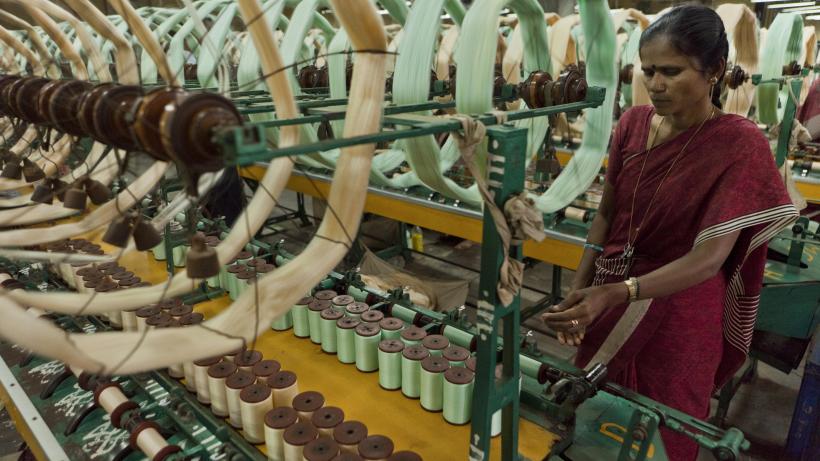Context:
A parent working outside the home must have someone to take care of their child. In India, family structures have historically often filled this need, with fathers working outside the home, and mothers providing child care and elder care.
Issues with existing care work model of India:
- However, this model is not conducive to India’s growing ambitions. If the country is to grow into a $5 trillion economy, women must be included.
- There are two specific ways to get here: women’s work, often care work, must be appropriately valued, and women must be adequately supported to participate in economic activity outside the home.
- All women work, but not all of them get paid. Economist Claudia Goldin’s 2023 Nobel Prize-winning work demonstrates this across American history.
Time Use Survey (TUS) findings:
- India’s first national TUS released in 2020 by the National Statistical Office (NSO), finds that 81.2% of all women are engaged in unpaid domestic services, compared with 26.1% of men.
- It finds that men spend 42 hours on average on activities within the production boundary, i.e. what is traditionally counted as economic activity, whereas women spend 19 hours.
- However, women spend 10 times more time on household maintenance and care for children, the sick and the elderly — 34.6 hours versus 3.6 hours.
- There are two implications for this: working women face the dreaded “double burden”, where working outside the home and contributing to family income does not come with a commensurate reduction in household responsibilities, and the care work that they do spend time on is not counted in the larger economic estimates, leaving us with exhausted women with lower leisure hours in a week than their male counterparts.
Women’s unpaid work:
- It plays a vital role in the economy: it is responsible for 7.5% of GDP, according to an SBI report. In other words, not only do women shoulder the burden of domestic work, but they also boost the GDP in the process. Yet in the official logs, they are not working.
- Governments should change the way they value this labour. India can call for and lead the change in the internationally defined System of National Accounts so that changes can be incorporated into everything from GDP calculations to Census questionnaires.
- When uncounted, women’s work remains invisible, which has implications for labour and employment policies. For example, statistical invisibility pushes household labour “outside the realm of protective labour legislation,” which limits the work day and regulates labour conditions. Women in India work 1.5 hours longer a day than men, mostly unpaid, often in unsanitary conditions.
Another facet:
- There is another face to this picture: supporting women working outside the home. In low income families, single income households are often an impossibility — both parents work simply because they have to. This means that the breadwinner -caregiver model begins to break down.
- Low income women are working without support far more often than expected. This again is not reflected in the data because of volatility — women’s work patterns are seasonal, sporadic and irregular and they often contribute to family businesses from within the home.
- A study revealed that approximately 44% of women were part of the labour force when considering a period of four months, but only 2% of women were counted when considering an extended period of four years. Domestic obligations keep them from regular employment — and when they do, it is often with children in tow.
- All subsequent efforts and public funds directed towards education, health and skilling are then built on a weak base. The government already runs the world’s largest public system for child services, the remarkable Anganwadi system, which reaches 80 million children of up to six years of age through 1.4 million centres. These centres function best in a rural setting, where community members participate together. However, since they are only open from 9 a.m. to 1 p.m., women still need additional care options if they are to work a full eight hour day.
- A fast urbanising India needs different models to support its women. Creches offer one solution: as of 2020, the National Creche Scheme operates nearly 6,500 crèches across the country. Creches help mothers build stable careers, as well as give children — who would otherwise be exposed at work — a safe, nurturing environment.
- The private sector recognises this need, and provides services for high income families: the childcare/preschool ecosystem is an estimated ₹31,256 crore industry, expected to grow at 11.2% CAGR till 2028.
- There is an imperative, therefore, for the public sector to ramp up its already considerable efforts, to counteract the base inequality of income and provide high quality child services to all.
Conclusion:
Today, the women’s labour force participation rate (FLFPR) in India is 32.8% according to government sources and 24% according to the World Bank, compared to China’s 61%, Bangladesh’s 38%, Nepal’s 29% and Pakistan’s 25%. If India wants to raise its FLPR to empower its women, myths around women’s work must be dispelled, and women’s work must both be counted appropriately and supported fairly.



.jpg)
Comments (0)